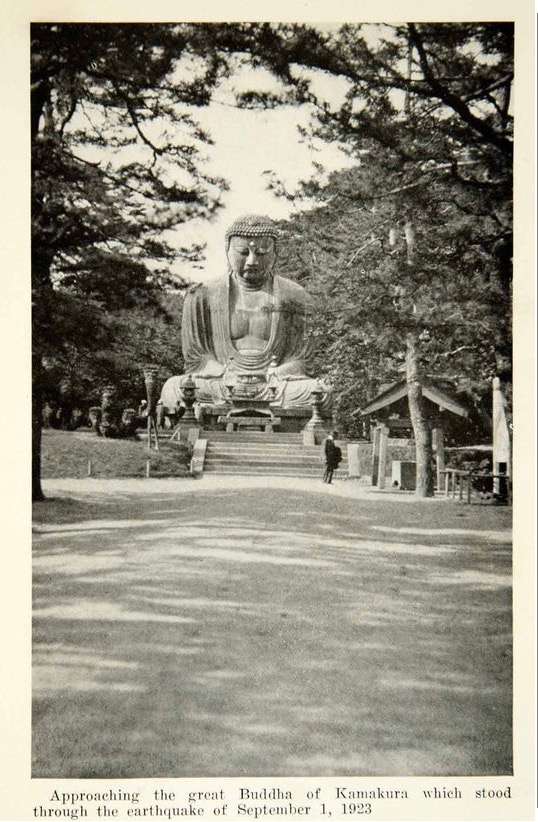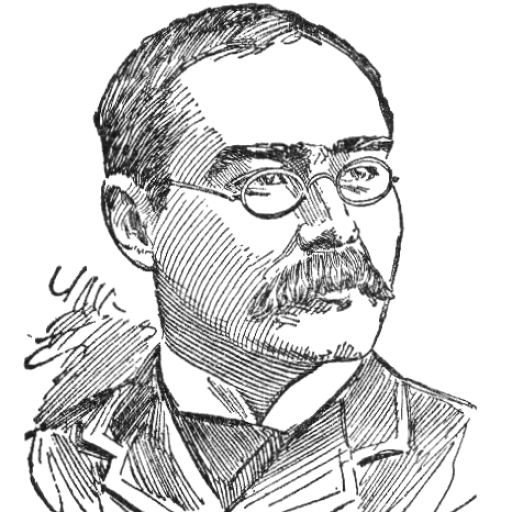The Soul of all the East …

Kipling had a life-long fascination for Buddhism. His novel ‘Kim’ is a song of praise for Buddhism (in the portrayal of the old Buddhist monk, Kim’s teacher, whom Kipling depicts with so much love and reverence). This deep respect for Buddhism reverberates through the poem ‘Buddha at Kamakura’, in which one can indeed feel “the Soul of all the East”. Most Westerners come to see “a tourist-show, a legend told, / a rusting bulk of bronze and gold”, take snapshots and go home, having totally missed the deep meaning of Buddhism.
Kamakura, nowadays at the southern limit of the Tokyo metropolitan area, rivaled for a time the imperial capital Kyoto as the cultural center of Japan. It gave its name to the Kamakura Period (1185-1333 AD), in which new forms of Buddhism (in particular Zen Buddhism) arose in Japan and new literary forms developed. At Kamakura there is a 49-feet-high bronze statue of a serene, compassionate-looking Buddha, dating from 1252, which is one of the national cultural treasures of Japan.
I experienced the extraordinary power of a Buddha statue, when I went to visit the huge reclining Buddha in Bangkok – it must be over a hundred feet long and fifteen feet high, all gilded with stamp-size gold leaves. Following the instructions of my guide I placed flowers in front of it, lit candles and incense sticks, and was getting ready to stick a gold leaf on the statue. Just at that instant a whiff of wind tore it out of my hand and lifted it right in front of the Buddha’s face. For a whole minute – which felt like eternity – it hovered there under the Buddha’s intent and serene gaze, then settled slowly on the Buddha’s shoulder. My guide, dumbfounded, gasped and whispered, “You must be a very lucky man…”
Buddha at Kamakura
O ye who tread the Narrow Way By Tophet-flare to Judgment Day, (1) Be gentle when "the heathen" pray To Buddha at Kamakura! To Him the Way, the Law, apart, Whom Maya held beneath her heart, (2) Ananda's Lord, the Bodhisat, (3) The Buddha of Kamakura. For though He neither burns nor sees, (4) Nor hears ye thank your Deities, Ye have not sinned with such as these, His children at Kamakura. (5) Yet spare us still the Western joke When joss-sticks turn to scented smoke (6) The little sins of little folk That worship at Kamakura - (7) The grey-robed, gay-sashed butterflies That flit beneath the Master's eyes. (8) He is beyond the Mysteries But loves them at Kamakura. And whoso will, from Pride released, Contemning neither creed nor priest, (9) May feel the Soul of all the East About him at Kamakura. Yea, every tale Ananda heard, Of birth as fish or beast or bird, While yet in lives the Master stirred, (10) The warm wind brings Kamakura. Till drowsy eyelids seem to see A-flower 'neath her golden htee The Shwe-Dagon flare easterly (11) From Burma to Kamakura, And down the loaded air there comes The thunder of Thibetan drums, And droned - "Om mane padme hum's" (12) A world's-width from Kamakura. Yet Brahmans rule Benares still, (13) Buddh-Gaya's ruins pit the hill, (14) And beef-fed zealots threaten ill (15) To Buddha and Kamakura. A tourist-show, a legend told, A rusting bulk of bronze and gold, So much, and scarce so much, ye hold The meaning of Kamakura? But when the morning prayer is prayed, Think, ere ye pass to strife and trade, Is God in human image made No nearer than Kamakura? (16)
Notes
[1] A reference to Christians, Jews and Moslems (Tophet is the Biblical word for Hell).
[2] ‘Maya’ – the visible world, considered by Eastern philosophy to be only an illusion of the senses.
[3] Ananda was Buddha’s favorite disciple; a Bodhisat (Bodhisattva) is a person who has attained Buddhahood.
[4] Western religions are based on the belief in an all-seeing God, who rewards the just in heaven and burns the evil ones in hell; Buddhism, in contrast, teaches the Law of Karma – that every action creates its own recompense or punishment. Just like the law of gravity guarantees, without divine intervention, that if you jump off a tall building you will come to harm, so does the Law of Karma (the inevitable consequences of any action) assure that one may transgress the moral Teachings only at one’s own cost.
[5] Consequently, obeying the Teachings keeps Buddha’s followers from sin.
[6] ‘Joss sticks’ – incense sticks.
[7] As in any religion, the majority of Buddhists keep only a few ceremonies, such as burning joss-sticks in front of a Buddha image. Western observers who mock Buddhism because of this totally miss the vast spiritual teachings of Buddhism.
[8] The kimono-clad Japanese.
[9] ‘Contemning’ – despising.
[10] The Buddhist teaching of reincarnation.
[11] A magnificent Buddhist pagoda in Rangoon, where Kipling during his 1889 voyage was intoxicated with its flaring colors: “… lilac, pink, vermilion, lapis lazuli, and blistering blood-red under fierce sunlight …”
[12] ‘Om mane padme hum’ – the basic Buddhist incantation, meaning approximately “the jewel in the lotus” (i.e. the Buddha). Whole books have been written about the hidden meanings of this phrase.
[13] Buddha preached his original sermons near the holy city of Benares (now Varanasi). By the third century B.C. Buddhism was dominant throughout India, but several centuries later the Brahmans won India back to Hinduism.
[14] Buddh-Gaya is the place where Buddha achieved enlightenment.
[15] ‘Beef-fed zealots’ – Christian missionaries. Buddhists are meant to be vegetarian.
[16] i.e. you – supposedly followers of Jesus Christ, who taught non-aggression and threw the traders out of the temple – before you start your daily transgression of your master’s teachings (“ere ye pass to strife and trade”), think whether Buddha may not have been a greater example of the Divine in human form.
